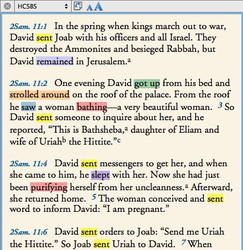This week we’ve been discussing how finding repeated words in a passage can make you aware of its major themes and motifs. On Monday, I showed how to use Accordance’s highlighting tool to highlight key words so you can begin to notice patterns. Yesterday we applied this method to 2 Samuel 11, highlighting every mention of cleansing and then unpacking how those key words are used to develop a particular theme. Today I want to look at another oft-repeated word in 2 Samuel 11 and show you a few helpful shortcuts along the way.
 If you work your way through 2 Samuel 11 and just begin highlighting the actions taken by the main characters, a pattern very quickly emerges. Can you see it? In this handful of verses, the word “sent” is used over and over again.
If you work your way through 2 Samuel 11 and just begin highlighting the actions taken by the main characters, a pattern very quickly emerges. Can you see it? In this handful of verses, the word “sent” is used over and over again.
The advantage of highlighting key words as you work your way through a passage is that it can alert you to repeated words like this. But once you’ve noticed a pattern, there is no longer any point in working your way through the text looking for every remaining occurrence of that word. Once the pattern has emerged, that’s the time to switch gears and have Accordance complete the pattern for you.
In other words, now that we know the word “sent” gets repeated, we want to find all other occurrences of the word “sent” as quickly as possible. That way, we can move immediately from gathering the relevant data (observation) to analyzing that data (interpretation).
One obvious way to find all the other occurrences of “sent” in 2 Samuel 11 is to search for it. You can do that by right- or control-clicking the word “sent” and choosing Word from the “Search for” submenu of the contextual menu.
This will open a new tab showing every occurrence of the word “sent” in the entire Bible. Since I’m only interested in the occurrences of this word in 2 Samuel 11, I would then limit the search by defining a range for 2 Samuel 11 in the Range pop-up menu or by using the Range command. Either approach will show me that “sent” is used no less than nine times in this chapter.
Searching for the word “sent” in this way has two advantages. First, it’s instantaneous (as most Accordance searches are), where reading through the passage looking for each occurrence is time-consuming. Even more importantly, I can be confident that every occurrence of the word has been found, where I might easily miss one or more occurrences when trying to spot them myself.
Now that I’ve found every occurrence of “sent,” I can instantly highlight the ones I haven’t already highlighted by hand. To do this, simply shift-click the desired highlight style on the highlight palette. Shift-clicking a style will apply that style to every “hit” word resulting from a search. Using this method, you can very quickly highlight key words in a passage. And once again, the advantage of such shortcuts is that it moves you more quickly from the work of observation to the more engaging process of interpretation.
Up to now, I’ve been looking for repeated words in an English translation (the HCSB). For most of us, that’s how we have to work through a passage, and that’s perfectly fine. In most cases, the repetition of a word in a translation actually reflects the repetition of a word in the original Greek or Hebrew, but that’s not always the case. It may be that a Greek or Hebrew word is translated by different English words in the same passage, in which case our search for repetition in English would miss instances of repetition in the original. Conversely, it may be that the same English word is used to translate different Greek or Hebrew words, in which case we would be seeing repetition in the English which is not actually present in the original. In my next post, I’ll show you how to make sure the repetition you’re seeing is really present in the original.


